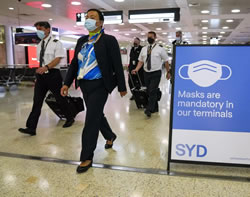Just when we thought the end was in sight, the Omicron variant has thrown a curve ball but Dan Schawbel* says this is no time to surrender to pandemic fatigue.
 Chances are you know someone who has already had COVID-19, is dealing with it now, or will contract it in the near future.
Chances are you know someone who has already had COVID-19, is dealing with it now, or will contract it in the near future.
I know many of us hoped that the Delta variant would be the end of the pandemic, but Omicron, while milder by most accounts, is also far more transmissible.
Employers are already feeling the effects of this new variant, which currently accounts for 95 per cent of new cases.
First, people are taking many more sick days — if they even have enough sick leave to use — and these absences are creating severe staffing shortages.
Other costs are much harder to measure.
These include lower morale among employees who have to shoulder the burden of sick workers, along with the constant stress of worrying if they will catch COVID-19.
In fact, pandemic-induced stress and disruption can make even healthy people feel unwell and absent-minded.
So don’t be surprised if all of your workers are less productive than usual right now.
Two years into the pandemic, I know most of us are genuinely fatigued from having to deal with it.
Still, I believe that now it’s more important than ever to develop a resilience plan that will help see your organisation through these trying times.
Some aspects to consider are practical. Should you delay reopening your offices? How should you cope with an influx of workers calling in sick?
Other aspects of coping with the Omicron surge are psychological.
What steps can you take to protect your healthy workers? How can you provide yourself and your employees with a measure of psychological equilibrium as a much-needed emotional buffer?
Although the approach will vary depending on your business, your location, and the number of employees, here are some broad ways you can adjust to the current reality.
Remind yourself that it’s not forever.
Adopt an attitude of forbearance. Tell yourself “this too, will pass”.
Omicron has impacted different parts of the world at different rates. While we haven’t fully turned the corner yet, cases are levelling off.
So, this is hopefully a short-term problem. Still, it requires intelligent solutions as well as the ability to nimbly respond to any future variants.
Reconsider your return-to-office plans.
A few months ago, some organisations were eyeing early 2022 for a return to the office, but Omicron has forced many to revise their plans, at least for now.
If you’re still planning to reopen your workplace, consider a hybrid approach or use staggered schedules to avoid having too many people in the office at once.
Keep an eye on your local infection rates, since the risk of workplace infection is correlated with the community infection rate.
Stay vigilant about keeping workers safe.
There was a growing sense of optimism late last year with some offices reopening, but almost overnight, Omicron took us back to square one.
That means employers again have the responsibility to act swiftly and responsibly to help mitigate the risk of infection.
Remind your employees to remain physically distanced from each other and to wear their masks properly.
Put a zero tolerance policy in place for this if necessary, and if you haven’t already done so, create a modified workplace layout that supports physical distancing.
This can be desks spaced apart, one-way traffic in hallways, and fewer employees allowed in conference rooms.
Create teams who can cover for each other.
You may want to consider creating teams of two or more who can cover for each other.
Perhaps the ‘A’ member of the team goes to the office on Mondays and Wednesdays while the ‘B’ member goes in on Tuesdays and Thursdays.
If the ‘A’ member is off sick or isolating, the ‘B’ member will cover for them, and vice versa.
This isn’t just about having employees cover each other’s shifts.
It’s a good idea to encourage your workers to pass on key information about their role and responsibilities to at least one other person on their team.
That way, if they need to call in sick there will be a seamless transfer to others who can pick things up right where they left off.
Stay on top of new guidelines.
Preliminary data shows Omicron is up to three times more infectious than the Delta variant.
The silver lining is that Omicron has a shorter incubation period than Delta.
As a result, guidelines covering isolation periods for mildly ill and asymptomatic individuals, and quarantine periods are changing.
It’s critical that you continue to check these guidelines for any new requirements and recommendations.
More importantly, you need to keep your workers informed.
Continue to support workers’ mental health.
There’s no question that COVID-19 has challenged our collective sanity more than ever.
Many organisations have made immense strides in supporting the mental health of their workforce, and it’s critical that this support continues.
This means encouraging practices that align with self-care (e.g., taking micro breaks).
It also means promoting a culture of wellness at work, where managers and leaders model the right behaviour.
Take care of your team members, and they’ll be there for you.
LinkedIn’s new Global Talent Trends Report drives home the fact that employees want to work for those who value their physical and emotional wellbeing.
While the Omicron variant creates numerous challenges, it also gives you an opportunity to align your organisation’s values more closely with your workers’ values.
This is an excellent retention strategy during the Great Resignation or Reshuffle.
Transparency is the key, so be specific about your plans to address health and safety, staffing shortages, and office reopening plans.
*Dan Schawbel is a bestselling author and Managing Partner of Workplace Intelligence, a research and advisory firm helping HR adapt to trends, drive performance and prepare for the future.
This article is part of his Workplace Intelligence Weekly series.











